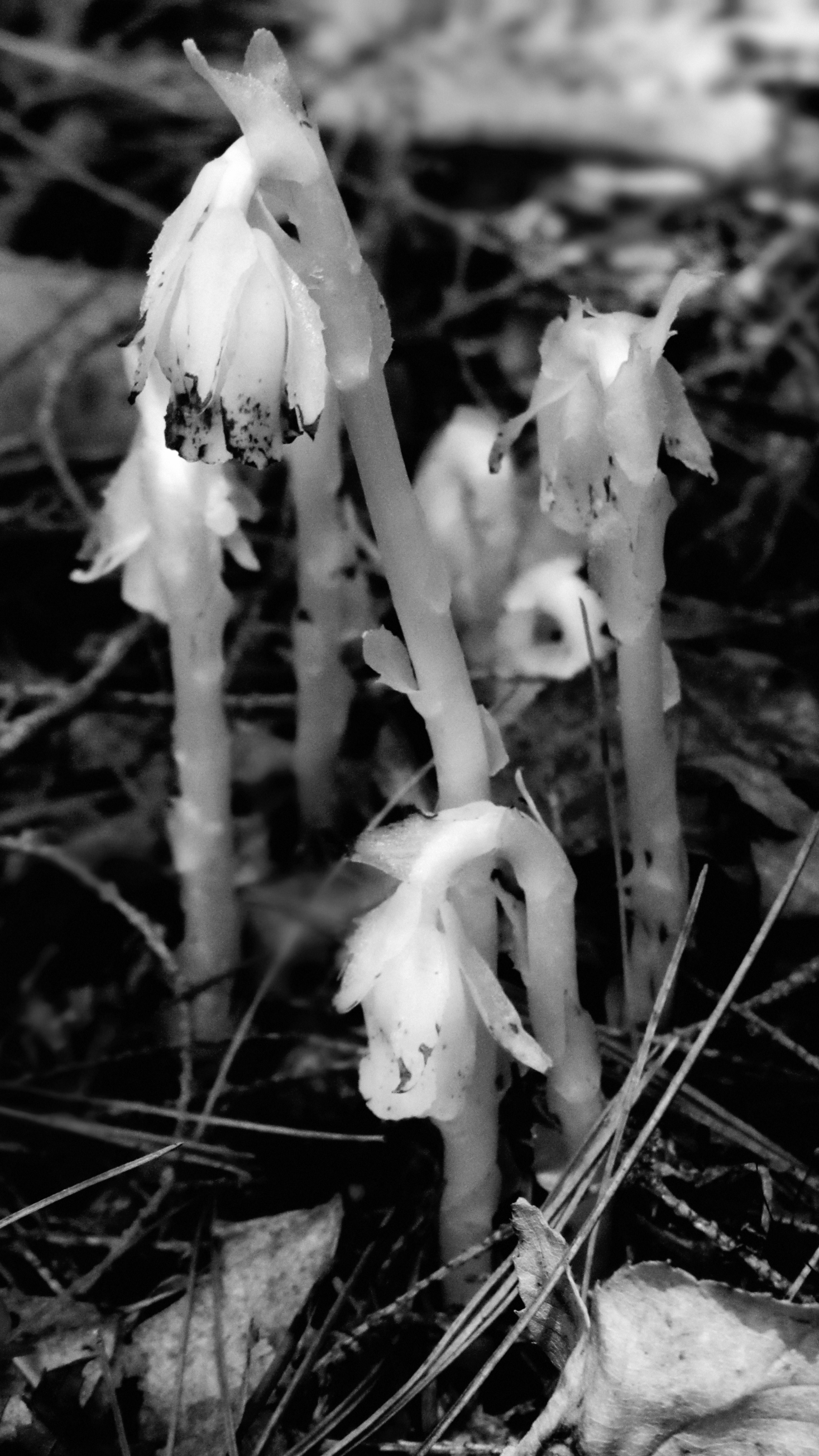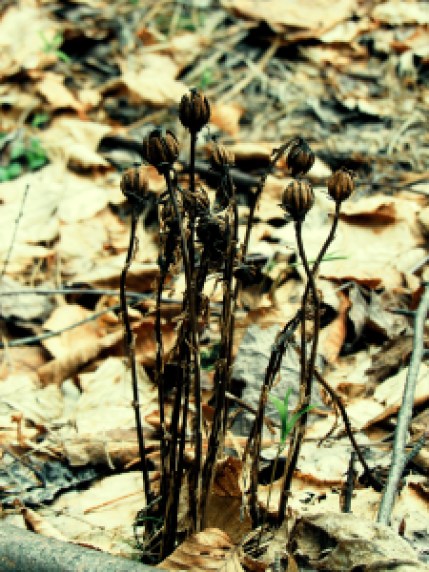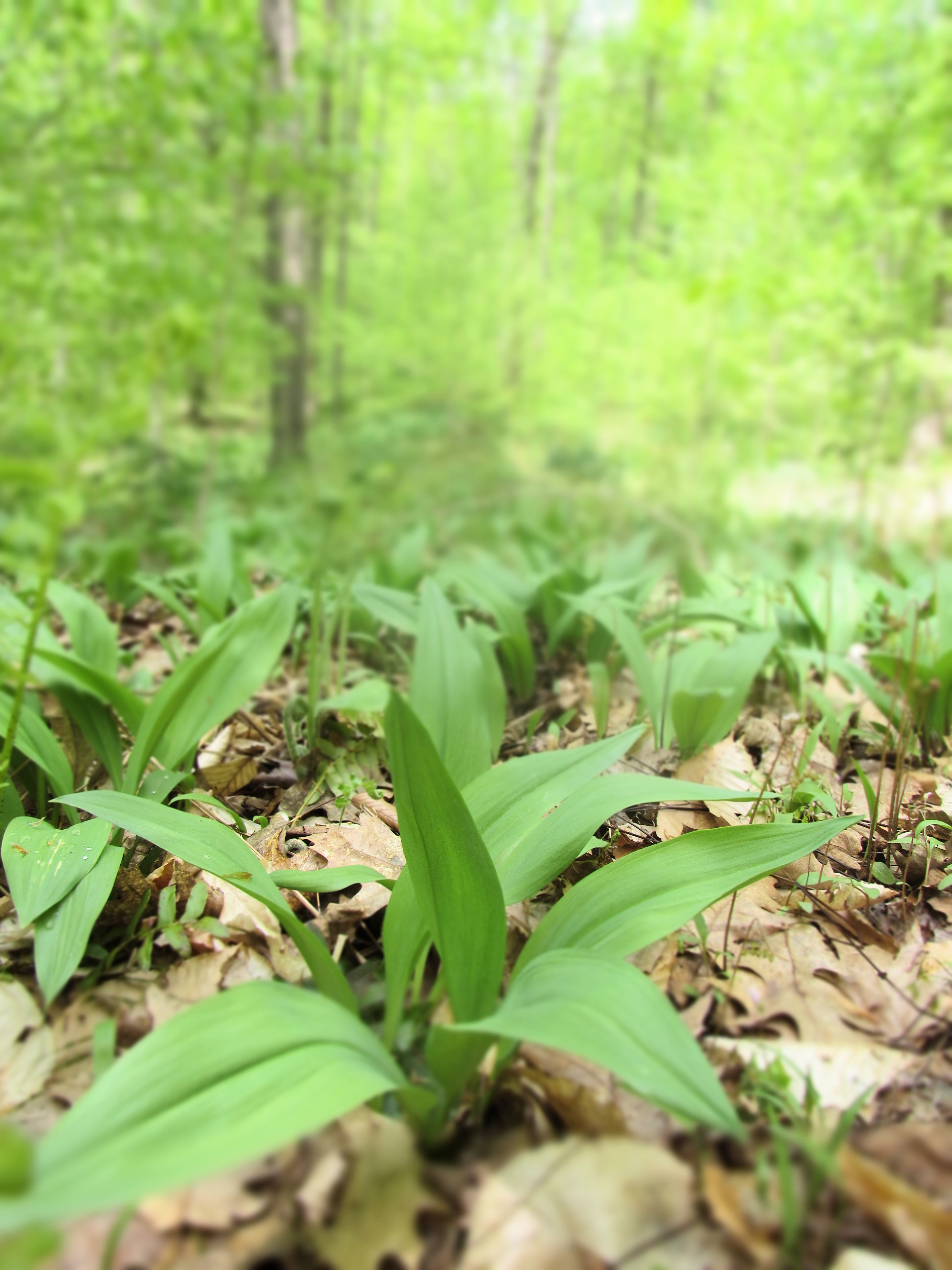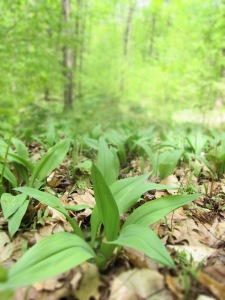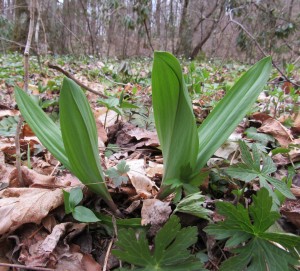UPDATE: Hello friends! Many folks in the herbal community are becoming increasingly concerned about ethical wildcrafting and human carelessness when wild harvesting plants for medicine. Ghost Pipe in particular is a vulnerable creature and Sean Donahue has written eloquently about how we humans can do damage both accidentally and on purpose. Please check out his post in addition to what I’ve offered here. It’s good to know this plant, and its good to refrain from its medicine if feel we don’t have its full blessing. If its possible for your body and life structures, venturing out and sitting at the feet of the wild-growing medicines will not only help you learn what the plant teaches, but help us understand the anti-materialist practices and potential of energetic and subtle-body medicine.
+ + +
There is a lot of lore and and witchy writing out there about this succulent and eerie little creature, and I am no more immune to its draw than the next plant nerd. This summer I’ve been quite aware of the small clusters of these nodding flowers as they observe my human doings en route to the swimming spot or napping in the hemlock groves.
If you’ve never sat with Ghost Pipe, allow me to describe how it grows with two or twelve companions in stands no more than ten inches high, clustered through damp acidic coniferous groves and often in companionship with Ganoderma (Reishi) and Mitchella (Partridge Berry). The waxy paleness of the plant earned it the common name Corpse Plant in New England, for the little fist that some think reaches from a grave, bruising a swift black when brushed against. Alice Morse Earle wrote in the early 19th centurey that Ghost Pipe is “the weirdest flower that grows, so palpably ghastly that we feel almost a cheerful satisfaction in the perfection of its performance and our own responsive thrill.” We give so many names to what we don’t understand, both poetic and explanatory: Ice Plant, Wax Plant, Convulsion Weed, Fit Plant, Death Plant.
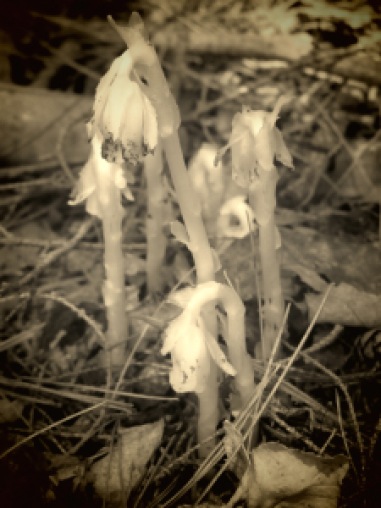 For further proof of the queer witchiness of this plant, I present you Emily Dickenson. It appears she retained a personal relationship with the Ghost Flower from childhood, and when her neighbor gifted her with a watercolor of the plant, Dickenson’s thank you letter contained tones of metaphysical shock: “That without suspecting it you should send me the preferred flower of life, seems almost supernatural… I still cherish the clutch with which I bore it from the ground when a wondering child, and unearthly booty, and maturity only enhances the mystery, never decreases it.”
For further proof of the queer witchiness of this plant, I present you Emily Dickenson. It appears she retained a personal relationship with the Ghost Flower from childhood, and when her neighbor gifted her with a watercolor of the plant, Dickenson’s thank you letter contained tones of metaphysical shock: “That without suspecting it you should send me the preferred flower of life, seems almost supernatural… I still cherish the clutch with which I bore it from the ground when a wondering child, and unearthly booty, and maturity only enhances the mystery, never decreases it.”
Oh my. Are you not convinced? Come meet this herb.
BOTANY & BIOGEOGRAPHY
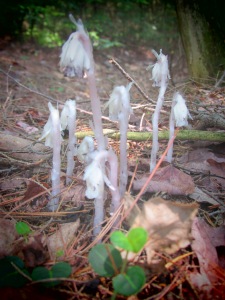 The latin binomial Monotropa uniflora indicates that a single flower grows terminally on an upright stalk in one direction, with the flower drooping its head over until it begins making seed. Monotropa uniflora is one of two species in its entire genus, its cousin being Monotropa hypopithys, or Pinesap, a similarly strange but far more colorful inhabitant of the. Formerly understood as a saprophyte which did not require chlorophyll for photosynthesis but rather took nutrients from decaying matter in the soil, Monotropa uniflora is now thought of as an epiparasite or mycoheterophyte known to survive in complex relationship with mycorrhizal fungi in the soil, which in turn interact with the neighboring photosynthesizing plants in a biome, usually the roots of a living tree such as beech, hemlock, or cedar. While the Ghost Pipe is thought to be primarily parasitic, the fungi in the soil form beneficial symbiotic relationships with the trees and shrubs, assistance in producing necessary sugars for the tree.
The latin binomial Monotropa uniflora indicates that a single flower grows terminally on an upright stalk in one direction, with the flower drooping its head over until it begins making seed. Monotropa uniflora is one of two species in its entire genus, its cousin being Monotropa hypopithys, or Pinesap, a similarly strange but far more colorful inhabitant of the. Formerly understood as a saprophyte which did not require chlorophyll for photosynthesis but rather took nutrients from decaying matter in the soil, Monotropa uniflora is now thought of as an epiparasite or mycoheterophyte known to survive in complex relationship with mycorrhizal fungi in the soil, which in turn interact with the neighboring photosynthesizing plants in a biome, usually the roots of a living tree such as beech, hemlock, or cedar. While the Ghost Pipe is thought to be primarily parasitic, the fungi in the soil form beneficial symbiotic relationships with the trees and shrubs, assistance in producing necessary sugars for the tree.
Dr. Ryan Drum explains this all so well:
Indian pipe, ghost plant, is a remarkable botanical curiosity as well as a powerful nervine. It is a mysterious, underground except when flowering, perennial common boreal non-photosynthetic flowering epiparasite. It parasitizes parasitic tree fungi, and is not dependent on one particular fungus, forming associations with at least a dozen different fungi, many of which produce edible mushrooms. It grows in complete shade on stable forest floors, usually where green plants do not. It seems completely dependent on its host fungi for organic nutrients. Its underground mass attracts fungal mycelial growth, from the fungi parasitizing live trees, both conifers and deciduous trees, providing myriad small knobbly papillar surfaces where nutrients pass from the fungal tissue to Monotropa. At least 14 species of trees can be used. I do not know if an individual Monotropa plant utilizes more than one fungal species or more than one tree species. I assume that the fungi derive some benefit from their associations with Monotropa, probably derivative secondary metabolites.
In his lovely writing on this epiparasite, Sean Donahue offers energetic observations of the plant based on its growth patterns, noting that while trees pass information and energy in a linear, centralized-library sort of stream between roots and branches, the network of mycelium and roots that Monotropa is tapped into allows for multi-directional, diffused, decentralized exchange. This interdependent physiology mirrors human neural networks, while the tender white tissues of each Ghost Pipe plant strangely resemble the structure of the mammalian brainstem. What can be seen here is the way that Monotropa interacts with the human nervous system, able to interpret, reorder and modulate large or chaotic amounts of information and stimuli.
Also, a note on herbivory: nothing seems to consider this plant a food staple.
PHARMACOLOGY & SPECIFIC INDICATIONS
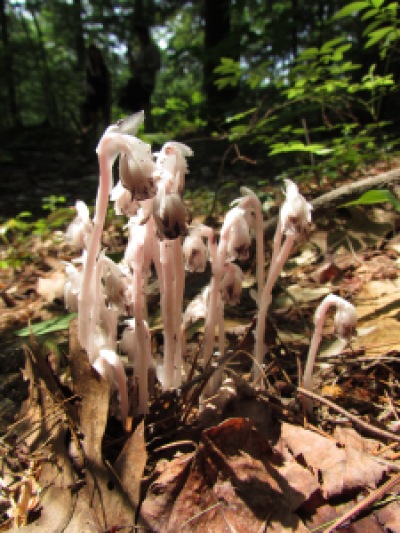 Monotropa uniflora emerges unobtrusively from the ground, quiet and still as a Greek chorus with some unanticipated piece of information on the tip of its tongue. The flowers erect and tender spines appear to hold each other up in their alignment, encouraging the clumps to hold its structure despite each plant’s delicacy and causing the herbalist to train the eyes to detect the upright patterning in the chaos of the leaf litter.
Monotropa uniflora emerges unobtrusively from the ground, quiet and still as a Greek chorus with some unanticipated piece of information on the tip of its tongue. The flowers erect and tender spines appear to hold each other up in their alignment, encouraging the clumps to hold its structure despite each plant’s delicacy and causing the herbalist to train the eyes to detect the upright patterning in the chaos of the leaf litter.
In a most general way, this profound nervine offers an quieting or cooling to an heated nervous states; older physio-medicalist texts and European documentation of First Nations traditional broadly describe the use of the herb for pain and neurological disruptions, such as seizures, convulsions, insomnia, extreme mental states, and regular muscular spasming. Felter and Lloyd, in the 1898 King’s American Dispensatory specify periodic fevers, childhood (febrile) seizures, elipectic seizures, opthamological inflammation, bladder inflammation. Most useful to me, however, have been the specific conditions or states for which the use of this plant are indicated.
I find it important to remember that Monotropa is able to help mediate both internal and external environments, whether the sensory imput comes from inside or outside us, whether it is physical or emotional. In my mind, Monotropa is the acute trauma relief precursor to Milky Oats’ tonic trauma support, creating the initial space that Milky Oats is later able to fill in a long-term nourishing way. Ghost Pipe seems to offer an aligning, re-regulating, reordering, and soothing of a chaotic mind or unmanageable pain.
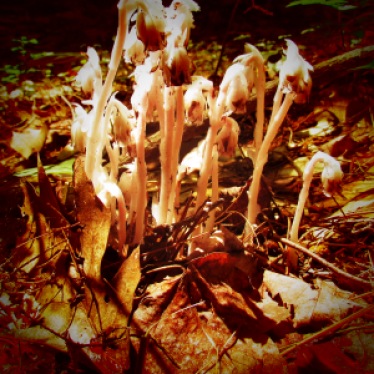 David Winston writes that Ghost Pipe is “not your normal analgesic.” Many people report the experience of taking this herb while experiencing strong physical pain and, while the pain does not go away, the individual is less attached to the pain, able to tolerate it, often feeling that they are standing beside it and watching it happen. Winston says this is called “antinociceptive,” meaning that the herb “reduces sensitivity to painful stimuli” and “raises the threshold for pain.” The same is true for emotional or psychologically painful situations, in which the person suffering is able experience relief from the intensity and to examine the experience with a little bit of spaciousness, a degree of separation. Sometimes, an individual experiences chronic or regular nervous dysregulation, either through painful autoimmune situations or extreme psychiatric states.
David Winston writes that Ghost Pipe is “not your normal analgesic.” Many people report the experience of taking this herb while experiencing strong physical pain and, while the pain does not go away, the individual is less attached to the pain, able to tolerate it, often feeling that they are standing beside it and watching it happen. Winston says this is called “antinociceptive,” meaning that the herb “reduces sensitivity to painful stimuli” and “raises the threshold for pain.” The same is true for emotional or psychologically painful situations, in which the person suffering is able experience relief from the intensity and to examine the experience with a little bit of spaciousness, a degree of separation. Sometimes, an individual experiences chronic or regular nervous dysregulation, either through painful autoimmune situations or extreme psychiatric states.
SPECIFIC INDICATIONS
+ Intense pain that interferes with ability to sleep + Painful conditions in which the individual needs to remain awake, grounded, present + Physical or emotional pain that is overwhelming + Pain that is paralyzing due to overload of sensory information, psycho-emotional shock + Anxiety or panic attack due to emotional or sensory overload + Headaches caused by traumatic brain injury + Acute psychiatric states, PTSD
PAIRINGS
+ Monotropa and Crataegus berry: vascular pressure from rebound trauma, brusing (Drum) + Monotropa and Sea Blush Roots (Plectritis congesta, a marine valerian): acute psychiatric conditions (Drum) + Monotropa and Canabis: unmanagable chronic pain (Donahue) + Monotropa, Staychys betonica, Clematis: headaches from traumatic brain injury (Donahue) + Monotropa and Anemone: anxiety, panic attack (Donahue) + Monotropa, Stachys betonica, Acorus Calamus, Ocimum sanctum: PTSD, triggering experience, disassociation, feeling stuck in memory of trauma (Donahue)
Dr. Drum notes that, while the plant’s flowering time depends on moisture, temperature, and fungal growth in the soils, the peak flowering time in much of North America appears to be July. Harvest gently to avoid bruising, wash debris away gently, tincture immediately. Flowers and roots could be used separately; using aerial parts only is advocated by Sean Donahue as most sustainable. The tincturing process results in a dark purple-black extract and a rich flavor. One friend of mine seems to think it tastes like vanilla and cinnamon. I have experimented on myself and friends according to both Donahue’s and Drum’s recommendations for dosing, which advise starting with 3 drops and increasing dose to 30 drops upon observation of reaction. For acute states, it is possible to administer or take up to 1 ml at 5 minute intervals. Dr. Drum notes that 15 ml of more can induce a deep sleep with strange, vivid, and sometimes erotic dreaming.
Be forewarned.
SOURCES
Donahue, Sean. Ghost Pipe: A Little Known Herb. American Herbalists Guild. http://www.americanherbalistsguild.com/sites/default/files/donahue_sean_-_ghost_pipe-_a_little_known_nervine.pdf
Zdenka Babikova, Lucy Gilbert, Toby J. A. Bruce, Michael Birkett, J
ohn C. Caulfield, Christine Woodcock, John A. Pickett, David Johnson. “Underground signals carried through common mycelial networks warn neighbouring plants of aphid attack.” Ecology Letters. (2013)
16: 835–843. Retrieved from http://onlinelibrary.wiley.com/
Harvey Wickes Felter and John Uri Lloyd. King’s American Dispensatory. 1898. Retrieved from http://www.henriettesherbal.com/eclectic/kings/monotropa.html
David Winston. Ghost Pipe. Facebook post. February 24, 2012.
Drum, Ryan, PhD. “Three Herbs: Yarrow, Queen Anne’s Lace, and Indian Pipe.” Retrieved from http://www.ryandrum.com/threeherbs.htm
